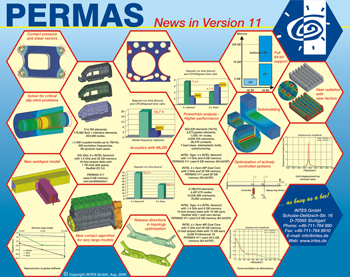New Features in PERMAS Version 11
The new Version 11 of PERMAS is the result of about 24 months development work. For a complete and detailed overview on changes, a Software Release Note is shipped with Version 11.
- Performance
- The MLDR solver for FS applications, a new parallel FS Eigenvalue solver kernel, faster reordering algorithms, assembly situations for modal frequency response, faster and more stable convergence for contact problems and improved performance for material nonlinear analysis are the main features to enhance performance.
- License management
- The new proprietary PERMAS license server provides flexible license management.
- 64 Bit architecture
- PERMAS now fully supports 64 Bit architecture of modern processors in the following execution modes:
- D32: Double precision floating point operations on 32 Bit machine words, memory usage of about 2 GB.
- D64: Double precision floating point operations on 32 Bit machine words, memory usage of about 8 GB.
- S64: Single precision floating point operations on 64 Bit machine words, practically unlimited memory usage.
- New Modules
- Weldspots: The new WLDS model improves accuracy of the force and displacement results and reduces mesh sensitivity.
- Extended Contact Aanalysis: Provides high performance algorithms for large contact models and a new nonlinear iterative solver for critical slip-stick problems
- Major extensions
- Submodelling: transfer results of a global model as boundary conditions for a remeshed submodel.
- Error indicator: supporting mesh refinement.
- Extended contact analysis: direct computation of contact pressure and shear in the contact surface, frictional energy, full support for inertia relief
- Assembly situations: much faster solution for large mode sets with multiple loading conditions in modal frequency response (modules DRA and FS).
- Fourier analysis: transformation of time dependent loads of a periodic process to the frequency domain.
- Residual iteration: improved time step stability for time integration with discrete nonlinear elements (module DRA).
- Random Response: modal random response analysis (module DRX).
- Fluid-structure coupling: fast MLDR method for vibration analysis of large models with many modes.
- Follower loads: nonlinearities pressure, temperature and inertia loads enhance the combined material and geometrical analysis (module NLS).
- Substructuring: now also available in nonlinear statics.
- Heat exchange by radiation: including view factor computation, now available in nonlinear heat transfer (module NLHT).
- Extended Optimization:
frequency dependent constraint limits and frequency dependent weighting of design objective,
optimization of correlation between given and computed frequency response,
optimization of actively controlled systems including the control element parameters,
support of modal frequency response analysis,
release directions are supported as manufacturing constraints. - Compressed input/output: the .gzip format can be directly processed by PERMAS.
- FELIX integration: improvements for the handling of larger models, the modelling of contact, support of MPC and distributed loads.
- New Elements
-
- LOADA: new family of membrane elements for the application of loads and the evaluation of stresses at the surface.
- CON: extension of the family of convection elements to include radiation effects and viewing factor computation.
- X1MOB1: new scalar fluid element to facilitate the specification of supports for fluid meshes.
